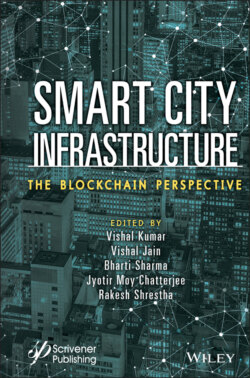Читать книгу Smart City Infrastructure - Группа авторов - Страница 37
1.5.3 Up-to-Date Tendency in IoT Blockchain Progress
ОглавлениеRecent developments in various technologies boost the progression of IoT and blockchain and its continuous revolution. The recent trend is principally revealed in four characteristics: popularity, range of applications, development of underlying technology, and business models [4–14].
1 i. Popularity: From the last few years, the incorporation of IoT with blockchain appliances proliferating. In the early days, IoT applied to specific domains like industrial manufacturing and transportations. However, as time passes, many emergent businesses converted to the movement of IoT like digitalization, smart home, E-healthcare, and then smart city. Dissimilar brands of consensus processes offered, and then, basic upgrading has planned for IoT blockchains.
2 ii. Range of Applications: From the invention, blockchain was continuously employed in various domains; at the start, blockchain applied for decentralized currency structures. Bitcoin was foremost considered to make a decentralized currency scheme exclusive of any administration. With the expansion of blockchain expertise, smart contracts in Ethereum have facilitated a more comprehensive range of appliances other than economic use. The merger of IoT into blockchain schemes affords extra capacities for appliances. Logistics businesses spotlight employing blockchain to execute product tracking: Computer hardware and power-driven manufactured goods trades exploit blockchain to improve the interface among humans with IoT devices. Power industries exploit blockchain to execute power distribution then power transaction dealings.
3 iii. Expansion of Basic Technology: The immediate progression of several principal technologies speedy development of IoT and Blockchain. IoT device connectivity, communiqué expertise like LoRa, LoWPRA, NB-IoT, and 5G communications with IoT devices improved quickly. To meet different blockchain appliance requirements, recently designed structures must be outfitted with optimization techniques. Public chains like IOTA and EOS with digital signatures resolve the low transaction rate difficulty in long-established accomplishments.
4 iv. Business Models: Many academic, industrial, insurance, and science-based companies are searching for possible chances for integrating blockchain practices in their business models to boost business turnover. But, the blockchain structure performance might rigorously distress the sustained companies’ productions, e.g., how much rapidly the consensus procedure legalizes dealings, which justify further concentration when manipulative industrialized appliances.
5 v. Resource Limitations: Usually, blockchain consumes high computational power, channel frequency with little delay. Extreme part of IoT smart devices outfitted with uncomplicated hardware setups with deficient processing, computational power. So, it is not an easy task for IoT strategies to execute various mining jobs of blockchain. Besides, most blockchain appliances employ PoW as their basic consensus algorithm, which requires high computation energy. On the other hand, blockchain is required to regularly present data encryption, but the encryption rate plus time will be dissimilar since dissimilar IoT strategies have dissimilar computational energy.
6 vi. Furthermore, other progressions, constancy models, and then regular testing need massive processing power, which excesses IoT devices’ low power ability. Furthermore, blockchain’s consensus practice involves the transformations of information among nodes regularly to reach an agreement to preserve blockchain’s accuracy and create novel blocks. This practice needs high bandwidth with little latency.
